
|
You entered: Mimas
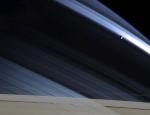 Mimas, Rings, and Shadows
Mimas, Rings, and Shadows
2.12.2004
Caught in sunlight, icy moon Mimas shines above a broad shadow across gas giant Saturn. In this remarkable image from the Cassini spacecraft, tiny Mimas is at the upper right. The broad shadow across...
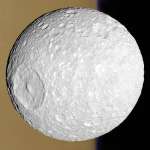 Mimas: Small Moon with a Big Crater
Mimas: Small Moon with a Big Crater
21.10.2014
Whatever hit Mimas nearly destroyed it. What remains is one of the largest impact craters on one of Saturn's smallest moons. The crater, named Herschel after the 1789 discoverer of Mimas, Sir William Herschel, spans about 130 kilometers and is pictured above.
 Herschel Crater on Mimas of Saturn
Herschel Crater on Mimas of Saturn
11.05.2010
Why is this giant crater on Mimas oddly colored? Mimas, one of the smaller round moons of Saturn, sports Herschel crater, one of the larger impact craters in the entire Solar System. The robotic...
 APOD: 2025 January 12 Б Mimas: Small Moon with a Big Crater
APOD: 2025 January 12 Б Mimas: Small Moon with a Big Crater
12.01.2025
Whatever hit Mimas nearly destroyed it. What remains is one of the largest impact craters on one of Saturn's smallest round moons. Analysis indicates that a slightly larger impact would have destroyed Mimas entirely.
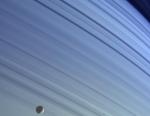 Blue Saturn
Blue Saturn
11.02.2005
Serene blue hues highlight this view of Saturn's northern hemisphere from the Cassini spacecraft. The image has been adjusted to approximate the natural blue color of visible sunlight scattered by the gas giant's upper atmosphere.
 The Moving Moons of Saturn
The Moving Moons of Saturn
27.06.2006
The moons of Saturn never stop. A space traveler orbiting the ringed giant planet would witness a continuing silent dance where Saturn's multiple moons pass near each other in numerous combinations. Like a miniature Solar System, the innermost moons orbit Saturn the fastest.
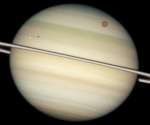 Saturn: Moons in Transit
Saturn: Moons in Transit
19.03.2009
Every 14 to 15 years, Saturn's rings are tilted edge-on to our line of sight. As the bright, beautiful rings seem to grow narrower it becomes increasingly difficult to see them, even with large telescopes. But it does provide the opportunity to watch multiple transits of Saturn's moons.
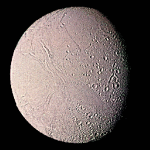 Saturn's Cleanest Moon: Enceladus
Saturn's Cleanest Moon: Enceladus
25.11.1995
Enceladus orbits Saturn between the smaller Mimas and the larger Tethys. Enceladus is composed mostly of water ice and has the cleanest and purest ice surface in the Solar System. It's surface therefore appears nearly white. The surface also has many unusual groves and relatively few craters, like Jupiter's moon Ganymede.
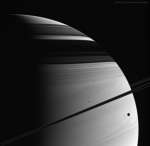 Moons, Rings, Shadows, Clouds: Saturn (Cassini)
Moons, Rings, Shadows, Clouds: Saturn (Cassini)
2.04.2018
While cruising around Saturn, be on the lookout for picturesque juxtapositions of moons, rings, and shadows. One quite picturesque arrangement occurred in 2005 and was captured by the then Saturn-orbiting Cassini spacecraft. In the featured image, moons Tethys and Mimas are visible on either side of Saturn's thin rings, which are seen nearly edge-on.
 Saturns Rings Seen Sideways
Saturns Rings Seen Sideways
18.10.1998
Saturn's rings are actually very thin. This picture from the Hubble Space Telescope was taken on August 6, 1995 when the rings lined up sideways as seen from Earth. Saturn's largest moon Titan is seen on the left, and Titan's shadow can be seen on Saturn's cloud tops!
|
January February March April |
|||||||||||||||||||||||||||||||||||||||||||||||||